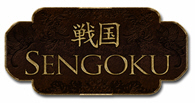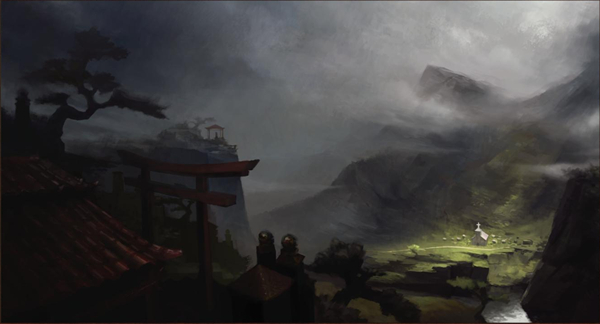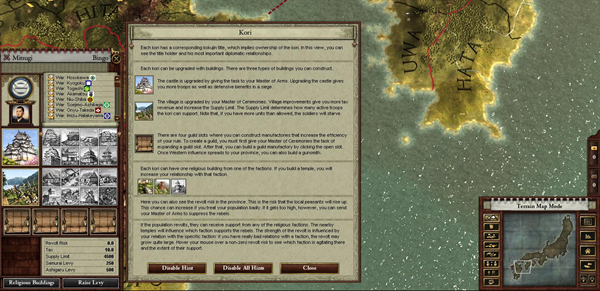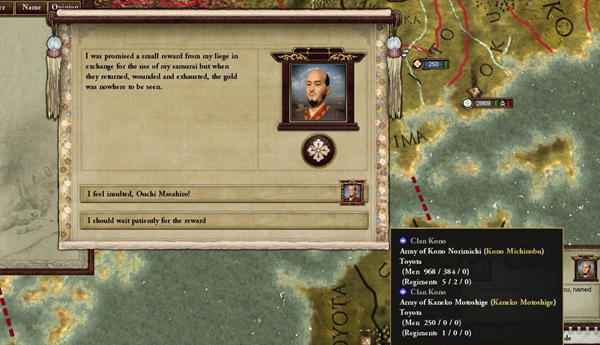Sengoku – PC Game Review
 Sengoku. PC Game Review. Developer & Publisher: Paradox Interactive. $23.99.
Sengoku. PC Game Review. Developer & Publisher: Paradox Interactive. $23.99.
Passed Inspection: Beautiful strategy gaming map with immersive gaming music, in-depth diplomatic and political mechanics, unique character-based faction strategy game, and quick load times compared to other Paradox Interactive releases.
Failed Basic: Military and warfare aspects are an afterthought. Tutorial system uses pop-up boxes that are annoying to the point where they may no longer useful to some players.
Games focused on the Japanese Civil War (Sengoku Jidai), which lasted from the middle 1400s to roughly 1600 AD, have been popular lately. I really don’t mind this. The Sengoku Jidai was an extremely volatile era which left us several examples of new innovative war tactics and unique diplomatic avenues. All these efforts culminated in the military and political unification of Japan. What made the civil war unique were the great number of participants and the similarities of their armies. This is why the by-products of the era were the result of adaptations by the many different clans vying for the Shogunate. Recently, an addition to the Total War games was released, Shogun 2: Total War. Shogun 2, despite its own disputable problems, gave PC gamers an immersive portal into the Japanese Civil War. Then, on September 13, 2011, Paradox Interactive released their own version of the time period which they named Sengoku. Does Sengoku outperform its peer, making it the go-to war game of this critical Japanese period that bears its name?
Sengoku is another real-time strategy game from Paradox Interactive. Upon launching the game the player finds loading screens of oil paintings of the peaceful Japanese landscape. The oil painting loading screens are seen in nearly all the strategy games made by Paradox Interactive over the last couple of years, of course with their own respective themes. These paintings do a great deal in setting the right mood for me when I start the game up. The loading time is also fairly short compared to the long wait for Hearts of Iron 3, another Paradox Interactive title.

With a game that focuses on what is called “Warring States Period” of Japan’s history, which has the word “war” in it, warfare should have been one of the most important aspects of that game.
Paradox did a fine job of music selection for the game, two very different types for the main menu and the campaign play. I was surprised to find out it was so much different from the music in its opposite number, Shogun 2, whose developers decided to go with the music of the original Shogun: Total War. The melodies in Sengoku don’t have the male grunting noises of the former two games but has songs, especially when viewing the main menu, that remind me of what you’d hear if you were in at a Japanese sushi/buffet restaurant. I wouldn’t consider this a bad thing. I feel the music in the main menu is quite welcoming and calming, which complements the type of game play Sengoku offers.
{default}The game doesn’t offer a tutorial option on the main menu, unlike Victoria 2 (also made by Paradox Interactive) which has a three-tiered extensive tutorial system. In contrast, Sengoku offers help via pop-up “hints” in boxes. I’m not really a fan of this type of training, but Paradox used this system in Hearts of Iron 2 and that game is still one of the most popular strategy games on the PC platform. The reason why I don’t like the pop-up approach is because the player has to click-on various things in the interface to find out what it does or how it works. I prefer a tutorial that lays it all out by category so players get the information they’re seeking, encompassing the whole category that they choose.
If you have no one else to play the game with, through LAN or Internet, you’ll be selecting the single-player option on the main menu. After doing so, you can either select a previous saved game to load or choose from a historical start. There are only four historical starts to choose from and they all began on May 26th, 1467, which I thought was odd. The difference between the choices is the clans and the regions of Japan you can play in. Unfortunately, you can’t start at any other date unless you load a previously saved game. Victoria 2 was similar in this way, and I hope this new Paradox Interactive trend isn’t a permanent fixture to their strategy games. One of the features that made the Hearts of Iron games so great was the multiple grand-campaign starting dates, and the several minor campaigns or conflicts to choose from. In contrast, Sengoku does give you the option to be one of the vassals of a clan if you don’t want to control the whole clan as daimyo. Usually these vassals control only one territory of a clan and they’re under the command of the clan’s daimyo.
The game is played almost exclusively through the strategy map interface. Much more beautiful and easier on the eyes than its Paradox counterparts, this map has snowy mountain peaks, winding rivers, and lush forests. The lighting effects of the sea are dazzling as well. These graphics sure do make the strategic map an enjoyable place to hangout. In addition, there are many buttons that change the look of the map, like “terrain,” “diplomatic,” or “revolt risk.” The terrain option obviously shows the awesome terrain; however, I’m usually using the “Clans” option so I can tell where the boundaries of my clan and my neighbors’ clans are.
After I started my first campaign I felt suffocated by the continuous hint pop-ups; they were getting annoying. They are also so big that they nearly block half the screen. But how else was I to learn how to play? In short, I was pressured into disabling all the hints simply because I couldn’t see the map. I thus continued to play the old-fashioned way, by trial and error.

The music had also transformed during campaign play. It seemed to be more immersive and aggressive with forceful drum-beating, as if it was pushing me towards war. So, now that I’m all hyped up for battle what do I wage war with? I was playing as the Hosokawa clan and I didn’t see any armies. Are they in my castles? No. I finally figured out I had to levy the armies from scratch. What a turn-off, especially when this period of Japan’s history was rife with clan vs. clan warfare.
The armies are sort of difficult to organize and build, and there isn’t much information given about your fighting forces. I levied a force in a province and it gave me a unit 750 strong (500 infantry and 250 cavalry). But it doesn’t say what type of infantry/cavalry. There is also a figure in each army information display for the number of arquebusiers. So apparently, yet again, Paradox Interactive has created a strategy game that treats military matters as an afterthought. This is also how the Europa Universalis series and the Victoria series dealt with everything military related. But Sengoku seems to have taken it a step further than the others, with really no good interface to build armies or study unit types. I personally don’t like this approach because I’m a military history enthusiast who enjoys strategic and tactical critical thinking while gaming. This lack of attention given to military affairs is surely disappointing for war gamers and is particularly vexing to players expecting a game named after the Sengoku Jidai – one of Japan’s bloodiest periods in history – to be channeled into a direction that discourages bloodshed.
Sengoku portrays the diplomatic and political aspect of running a state during feudal Japan very well. But, where it is strong in these areas it does lack in military and economic aspects. Players can appoint their court, make deals with their vassals (if they have them), and improve relations with neighboring clan members using gifts or proposing marriages. The game is definitely more character-based (daimyo, vassals, court officials, etc.) rather than faction-based, as the player is wheeling and dealing almost exclusively through characters.

These character mechanics are impressive and many different factors influence the characters. These include age, honor, intrigue skills, diplomacy skills, martial skills, and so much more. The characters can also attain traits like “Intricate Webweaver” or “Charismatic Negotiator” which increases or decreases the skills listed above. The titles the character in question currently holds, like daimyo or kokujin, are also tracked in the game. Consequently, with this in-depth character system you’d expect each character to have his or her own unique portrait, displaying what the character looks like, and they do, sort of, but all the male characters’ portraits have the same face – just the hair, eyebrows and facial hair differ. The same goes for the female characters. Graphics have never been Paradox Interactive’s strong-suit, but developing a game like this that’s mostly character-based, they should have spent more time making the portraits differ a bit more.
Another feature of the game is the plot system. Here you can plot things like breaking away from another clan if you’re a vassal, or plotting to attack another clan if you’re a daimyo. To execute each plot you have to have enough plot power. Each plot will use up a certain amount of plot power. This plotting feature adds yet another dimension to the already intricate, and perhaps overwhelming, diplomatic and political mechanics of the game. The “Ninja Clans” interface is also a nice addition, which displays the ninja clans under your employment. Ninja clans can be used for spying, sabotage, or assassinations. These choices give the player a nearly endless array of possibilities while fighting for their faction’s survival.
A player who chooses to use the numerous diplomatic and political features to become shogun is probably going to have to wait a long time to see results. Most diplomatic and/or political actions take time for their effects to be felt. So unless you have the patience to wait, you’ll probably be expanding your faction’s boundaries by using your military and fighting wars. This is indeed unfortunate because of the lack of attention the warfare aspect received from the developers. The battles are fought using variables like terrain or troop types and dice, common practice in Paradox Interactive releases. If you’re the type of gamer who likes to use a strategy in conquering, taking advantage of tactical improvements over opponents, then you better stay away from Sengoku. This game’s battles are essentially “up in the air.” It is difficult to estimate battle outcomes, thus they cannot be predicted or relied upon. I would personally try to stay away from the military part of the game as much as possible – but then again this requires a very patient player.
I feel Sengoku is a great idea that could have been spectacular. Though its release date wasn’t ideal, it would have served the game better had it been released before Shogun 2. Now, the two games will inevitably be compared, and I personally don’t see any reason to play Sengoku over Shogun 2 except for its diplomatic and political features. Paradox Interactive should have considered the recent games released that were the same era with the same genre, and thus should have made Sengoku an improvement over them. But it really isn’t. The game’s strategy map is eye candy and its interface is beautiful and informative, except regarding military things. This game is ideal for the strategy gamer who enjoys making diplomatic deals while intriguing with neighboring clans, or for anyone who likes to watch a character grow, develop and transform through time while possibly becoming shogun. If you like games that are primarily focused on diplomacy and politics, with almost useless military features, then this game is right for you. On the other hand, if you’re a hardcore war gamer like me and/or you like to apply what you’ve read in military history books to the PC gaming platform, then don’t waste your time with this one. With a game that focuses on what is called “Warring States Period” of Japan’s history – which has the word “war” in it – warfare should have been one of the most important aspects of that game. Such is not the case.
Does the game have a permanent spot on Curtis’ hard drive? Unfortunately, it does not. After playing through the campaign once I wasn’t enthusiastic to play a second time. Though the timing of the release of the game is also to blame for this, Sengoku must be judged by comparison to its peers. To date Shogun 2: Total War, which was released earlier in the year, fulfills all my feudal Japan needs. I was turned off by Sengoku’s lack of attention to the military and warfare aspects of the period, and playing strategy games that lack this portion of nation building usually bore me quite quickly.
Armchair General Score: 70%
About the Author
Curtis Szmania is an avid reader of military history, a hardcore PC war gamer, and enjoys building and overclocking computers. He reads from a variety of military history books ranging from Ancient Sumeria to the Korean War. He also has a soft spot in his heart for the underdogs in any conflict and is intrigued by a fighting force that overcomes overwhelming odds.


Even tho I do agree with you about the lack of a tutorial, why comparing Shogun 2 with Sengoku? We all know they do share some background, but PI games is all about strategy and very few about tactics.